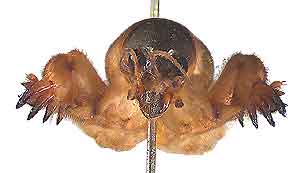
|
GRYLLOTALPIDAE Mole Crickets |
|
| ||||||||||||
|
Members of this family are known as mole crickets and are often heard, especially on warm, humid nights rather than seen. These crickets have become adapted to a habitat completely different from most other Orthoptera, spending most of their time in burrows below ground. Most species have well-developed wings and are capable of flight, often being attracted to lights on moonless nights.
Mole crickets are usually brownish in colour and are most recognisable by their large, flat forelegs, which are especially adapted for use as a shovel for excavating burrows. They have short, brown hairs covering their bodies, giving them a velvety appearance.
Mole crickets predominantly feed on vegetable matter but are also known to eat worms and other insects, which they may encounter, underground or just at the surface of the burrows. When mature, male mole crickets will sit in the entrance to their burrow in a specially designed dome shaped opening and sing for a mate. The shape of the burrow opening amplifies the sounds of their calls. This singing is also used to warn off other male crickets. Female mole crickets lay eggs within their own burrows, remaining close by to protect them until they hatch. The nymphs resemble adults but are smaller and lack wings. They develop through several moults, growing wing buds which eventually develop into wings with the final moult. For more molecricket species visit the Australian Insect Common Names - Gryllotalpidae section found here. |

